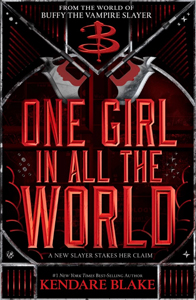With her second “Frankie the Vampire Slayer” entry, “One Girl in All the World” (January, hardcover), Kendare Blake again delivers a novel that’s partly appealing for its new generation of Scoobies and partly for the OGs and the references to their glory days (and Master days, and Mayor days, and The First days).
As we learned in last year’s “In Every Generation,” the “Frankie” timeline branches off from Willow’s creation of the Slayer army via the Scythe in “Buffy” Season 7. Nothing much happened in the next 17 years except her daughter Frankie was immaculately born and New Sunnydale was built.
Picking up in the same 2020-21 school year as “IEG,” Blake builds the “Frankie” continuity from the ground up, like New Sunnydale itself. The characters and how they interact are the appeal; Blake never gets bogged down in plot. Fun action scenes are quickly followed by conversations that give insight into characterization and relationships. While I take issue with plenty of elements, the characters are well-drawn and Blake’s prose is breezy and fun to read.

“Buffy the Vampire Slayer: One Girl in All the World” (2023)
Author: Kendare Blake
Series: Frankie the Vampire Slayer No. 2
Setting: An alternate timeline in Fall 2020, springing from “Buffy” Season 7, when Willow’s Scythe spell has the side effect of making her pregnant. “Angel” Season 5 marks the last of the established continuity referenced.
Willow, Oz and Spike
The three OG characters – Willow, Oz and Spike – are written decently, but not as deeply as they are in the comics at this point in the timeline, when they’ve been through a lot more. (SPOILERS FOLLOW.)
In an interesting segment, Willow and Oz examine their relationship, deciding for now that it defies description and that’s OK. They are somewhere between romantically involved and platonic friends. In real life, this unnamed type of relationship is often painful for at least one of the people, but Oz and Willow seem OK. This is also the case in the comics, but there Oz has achieved the “moving on” step.
While Blake never writes the OG characters wrongly, she doesn’t go particularly deep. Granted, Oz is a straight shooter, so he probably is content as an overseer of young werewolves. Spike, Frankie’s Watcher and the school librarian, likewise is easy to read.
At this point, the feelings on his sleeve primarily consist of worrying about Buffy – who is trapped in a prison dimension with the rest of the Slayer army leadership. Spike is trying to restrain himself from demanding that his student Frankie achieve Buffy-level slaying abilities overnight; I also wish he’d restrain himself from calling her “Mini Red” on every single page. Blake’s quippage is sometimes clever, sometimes indulgent.

Willow is mostly presented as Super Single Mom, a change from her troubled nature in the comics, where she is a recovering magic addict. But when the Scythe – symbol of the last time Willow used uber-magic — comes into play, her old worries resurface. But they more on the surface than in the robust comics.
Blake’s Scoobies
I don’t cringe when the OGs appear, but I am mildly thankful that Blake doesn’t go more than skin deep in exploring them. She can do “less damage,” so to speak, with her own creations. She feels freer writing about the Gen-Z Scoobies – for better or worse. They read like real teens, but their troubles carry less weight than the Oregon Trail Generation Scoobies.
Frankie, a physically awkward but increasingly effective Slayer under Spike’s tutelage, has a thing with ancient (and hot, natch) demon Grimloch. It’s a Buffy-and-Angel parallel … except that Willow knows about everything and isn’t overly worried. When she grounds Frankie, it’s a rote case of “This is what I’m expected to do.”
When Frankie and Grimloch kiss for the first time, I find it too easy for Frankie. Her shyness and awkwardness disappear as if Blake forgot about those traits. Later, Frankie is far too mature for a 16-year-old when she realizes she’s the “other woman” in a love triangle with Grim and rogue Slayer Aspen, who emerges as the Big Bad.
Also on the relationship front, there’s Hailey-and-Sigmund, and possibly Willow and her old (off page) flame Sarafina (Sigmund’s Sage demon mom). And Jake, the ladies’ man werewolf, develops feelings for his male pansexual best friend Sam. This seemingly makes him bisexual – a brave choice considering the debate within fandom (resurrected here by the Willow-and-Oz stuff) of whether Willow is bi or gay.
It’s too bad (although wholly expected in 2023) that most of “OGIATW’s” diversity is in the category of sexual orientation. It’d be nice to see more neurological diversity. Making Willow’s daughter (not exactly a cheerleader-turned-Slayer) so smooth out of the gate with romantic relationships is a missed opportunity. Frankie could’ve been a Slayer for the awkward kids (and adults).
Aspen? California, nice
Hailey is the kid sister of Vi the Vampire Slayer (played by Felicia Day on the show, to give you the visual), who is involved with the villains. These villains are, at first blush, overly reminiscent of Simone’s gang in “Buffy” Season 8. The Simone equivalent here is Aspen – she’s beautiful and has a romantic history with Grimloch. Like Vi, Grim has divided loyalties.
The goal of Aspen and her 10 rogue slayers is subtly different than Simone’s. Simone believed Slayer powers should be used for the individual Slayer’s (or collective Slayers’) benefit, not for the good of humankind. Aspen (and Vi, in an on-the-fence sense) believes Slayer powers are a curse – thus she loathes Willow. Aspen and her followers never asked to be in Buffy’s army, and they want out.
Broadly, this is a good villain motivation. I agree with Aspen that if she doesn’t want to be part of the Slayer army, she shouldn’t have to be. But “OGIATW” would’ve benefited tremendously from more specifics. Our heroes ask Aspen if she ever discussed her views with Buffy, and Aspen brushes off the notion as a waste of time.
Blake writes herself into a logical corner here. Imagine if Aspen had approached Buffy with her concerns. The Buffy we know from the TV series would sympathize with her. Buffy would tell Aspen the Slayer army is voluntary and she should do what she feels is best for herself and her views.
As long as she doesn’t hurt others, of course. This is the twist, albeit not played with much drama by Blake: Aspen does perhaps want to hurt others. Our heroes are suspicious that Aspen doesn’t want to drain her powers (and those of the other rogues) and live like a normal person; rather, she wants to become a Super Slayer.
More information needed
Aspen could grow into a strong villain in the trilogy capper (due in January 2024) if we’re allowed more details about her background and philosophy. Hailey aims to magically infiltrate the rogues, so perhaps Blake is planning those very details.
One thing in Aspen’s favor is that she is a new character, rather than a resurrection. Another recent release from Disney Hyperion is called “Big Bad,” and “OGIATW” could almost be called “Little Bads.” As part of the get-the-Scythe scheme, Vi and Aspen use magic to draw demons to New Sunnydale. These include many familiar faces from the TV series – including a few paragraphs featuring the Gentlemen.
The way Blake introduces familiar demons is fun in the moment; her descriptions make it into a game of “Guess the ‘Buffy’ encyclopedia entry.” Through two books, though, the “Frankie the Vampire Slayer” series is a shadow of the original continuity, and a parade of throwback references only remind the reader of this. Blake’s passion is evident, and I will be back for book three, but I doubt the shadow will entirely go away.

